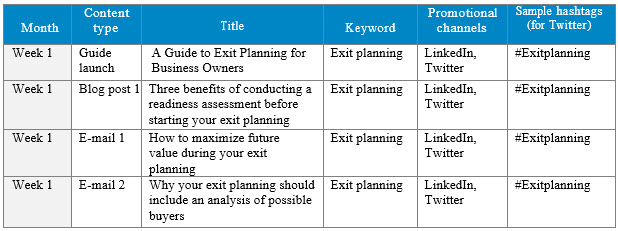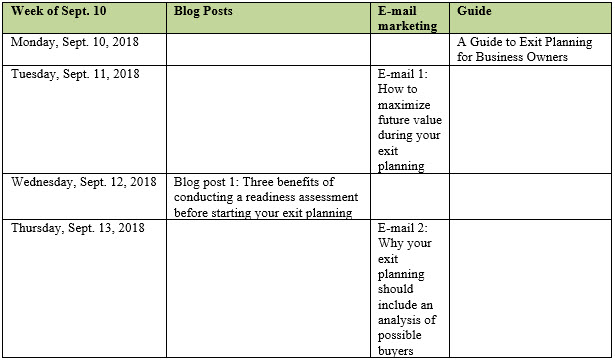How to Build Your Editorial Calendar
Implement Your Content Marketing Strategy
To successfully implement a content marketing plan to support your firm’s overall marketing goals, you need to build an editorial calendar. In a solid, well-planned editorial calendar, everything is planned out in advance, from scheduling to headlines. In this post, Dr. Lee Frederiksen shares some tips for creating an editorial calendar.

[su_pullquote align=”right”]Resources:
Marketing Techniques: Content Marketing and Thought Leadership
Marketing Techniques: Social Media, Networking, and Referrals
Gaining an Advantage in a Changing Marketplace
How to Become a High Visibility Expert
[/su_pullquote]
To successfully implement a content marketing plan to support your firm’s overall marketing goals, you need to build and editorial calendar. In a solid, well-planned editorial calendar, everything is planned out in advance, from scheduling to headlines. In this post, I will share some tips for creating your own editorial calendar.
More digital marketing tips like these can be found in Hinge’s How-To Guides from Hinge University, our online learning platform.
Step 1. Get Started on Strategy
Begin by setting up a spreadsheet similar to the table in Figure 1 (for illustrative purposes only). Generally, building out your calendar for one three- or six-month period at a time is preferable, since you will want to update it as your marketing priorities change over time.
Figure 1: Content Marketing Planning Spreadsheet

Step 2. Build Out Your Plan
The next step is to fill in the milestone dates for your long-format pieces, such as e-books or guides. Schedule the date that each final product is due, and then target dates for interim edits and the completed manuscript. As you work backward from the ultimate completion dates, be realistic about what your content providers can accomplish.
As you flesh out your calendar, develop a consistent schedule to help your audience know when they should expect to receive new content from you. Choose a day of the week for each type of content that you publish. For example, you could choose to publish a blog post every Wednesday, and e-mails on Tuesdays and Thursdays (at my firm, we have found these to be good days to send out content marketing e-mails).
As a final step, we recommend transferring your plan to a calendar with actual dates (see Figure 2) that will make sense to your team.
Figure 2: Content Plan Showing Actual Dates

Step 3. Repurpose Your Content
The good news is you do not have to create all your content from scratch. With a little ingenuity, you can repurpose much of your original content.
Start by looking at what you already have—like an old blog post that enjoyed a lot of shares. using such content as a starting point, you could create a short video. Or, you could turn several related blog posts into a long-format guide on the central topic.
So, as you plan your content titles, consider creating groups of five to eight posts that can be connected into one comprehensive document. Alternatively, you could write the guide and then break it into individual blog posts. The first approach involves less up-front work, while the second usually results in a more polished, unified guide. But either approach will deliver a valuable, in-depth piece that will help generate leads.
Step 4. Plan on Consistency
Successful content marketing strategy relies heavily on consistency and planning. As you develop a following (especially with your blogs), readers will come to expect your content to arrive on a regular schedule. If you post your content sporadically, there is a greater chance that people will stop reading or unsubscribe.
Try starting with two posts a month—frequent enough to build a readership, but far enough apart to be do-able. If you are able to publish more often, great! However, if it feels like too much, try finding another writer with whom to share the responsibility. Or even invite guest writers to share an outside perspective. Whatever you do, be consistent, so that your readers get a steady diet of valuable information.
That is essentially it! Creating an editorial calendar is not difficult…but it does take determination and follow-through. Stick with your plan, and your perseverance will pay off!
For more ideas and guidance on practical marketing techniques to implement at your firm, be sure to check out our Quick Start Kits and How-To Guides on this and many other marketing and branding topics at Hinge University.
Lee W. Frederiksen, PhD, is Managing Partner at Hinge, the leading branding and marketing firm for the professional services. Hinge conducts groundbreaking research into high-growth firms and offers a complete suite of services for firms that want to become more visible and grow.
Dr. Frederiksen can be contacted at (703) 391-8870 or by e-mail to LFrederiksen@hingemarketing.com.









